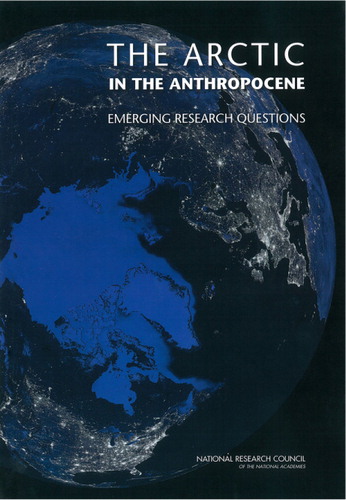Review of The Arctic in the Anthropocene—emerging research questions, by the Committee on Emerging Research Questions in the Arctic, Polar Research Board, Division of Earth and Life Studies, National Research Council of the National Academies (2014). Washington DC: The National Academies Press. 210 pp. ISBN 978-0-309-30183-1
The Arctic has long engaged both human imagination and scientific curiosity. Among others, this fascination is driven by the Arctic's sheer beauty, its remoteness and its intricate interplay of ice, water, air, soil, animals, plants and humans. This interplay has today become a focus of particular scientific interest because climate change impacts any interaction between the different players that constitute “The Arctic” across all spatial and temporal scales. With the ongoing changes, a wealth of new research topics emerges that is related to the functioning of the Arctic in the past, present and future.
The rapidity of the ongoing changes pose a particular challenge to scientists, since the limited understanding that we have of the Arctic as it is today obviously also limits our understanding of how the Arctic will change in the future. The recently published book The Arctic in the Anthropocene very clearly outlines these challenges and gives insightful guidance on how to best address them, managing in a very impressive manner to link the physical, biological and societal challenges that underlie the growing scientific interest in the Arctic.
The book is built around the formulation of emerging research questions, which allows the authors to address a wide variety of topics in a very succinct manner. This makes this book very readable and informative for scientists from all research fields that deal with any aspect of the Arctic. In discussing these questions, the book succeeds in particular in spelling out the unique nature of the interlinkages between the different players that define the Arctic, and gives a very informative overview of our recent understanding of the functioning of the Arctic.
The emerging questions are divided into five overarching topics. First, there's the “Evolving Arctic”, dealing with the ongoing changes that are largely driven by the ongoing global warming. Second, there's the “Hidden Arctic,” which relates to processes that are hard to investigate through existing research tools, for example, because they happen underneath the ice or occurred in the distant past. The third overarching topic describes the “Connected Arctic,” which deals with the physical, biological and societal interaction from within the Arctic to lower latitudes. The last overarching topic for which actual questions are formulated encompasses the “Managed Arctic”, discussing the possible impact of focused human interaction with processes governing the Arctic as we know it today. The fifth topic does not evolve around emerging questions, but instead deals with the “Undetermined Arctic.” This part of the book briefly discusses the fact that there probably are many questions that we can't even formulate yet. The authors strongly argue for remaining open for surprises as both time and our understanding of the Arctic evolve.
A second major part of this very readable book deals with ways in which these emerging questions are best addressed. I strongly recommend any funding agency to read this section, as it presents a very balanced view on the pros and cons of today's prevailing funding system. For example, the authors very nicely spell out the difficulties in obtaining funding for long-term observing systems, even though these are urgently needed if we want to build our understanding on reliable measurements rather than on speculation. The fact that these long-term observing systems often only pay off scientifically after many years of operation is clearly incompatible with much of the current funding system. The authors also ably make the point that not all our research must contribute directly to the welfare of society. For a system like the Arctic, where we often lack even the most fundamental understanding, curiosity-driven research is a vital component of science, despite the requirement of funding agencies that the work they sponsor must benefit humanity.
In addition to this fundamentally important guidance, this section also gives very concrete suggestions on how to best address the emerging questions outlined in the main part of this book. It addresses very clearly the sometimes difficult interplay between observations and models, between ground-based measurements and remotely-sensed satellite data, between industry and governmental research, between indigenous populations and scientists and, as such, complements the very interdisciplinary description of the emerging questions through a very interdisciplinary description of ways to address these questions.
After reading this book, I was very impressed by the breadth of knowledge that the authors have managed to compile in a very readable and concise manner. Being charged with compiling such a contribution to inform the US Interagency Arctic Research Policy Committee of the United States, the Committee on Emerging Research Questions in the Arctic drew from wide community input through a number of workshops and online questionnaires. Based on this input, they compiled a highly informative, very coherently written contribution that I can wholeheartedly recommend to all scientists with even a slender interest in the Arctic, policy makers, funding agencies and also lay readers who want to understand the large variety of reasons for why the Arctic fascinates us scientists and why it will continue to do so for many decades to come.

